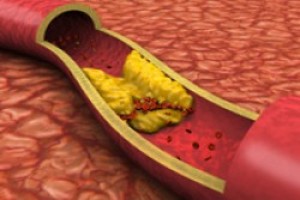Using Light and Sound to Detect Artery Blockage
Using Light and Sound to Detect Artery Blockage
Scientists have developed a 3-D imaging method that uses both light and sound waves to spot fatty deposits within tissues. The technique holds promise for noninvasively detecting atherosclerosis and possibly other disorders that involve fatty buildup.

Fatty deposits known as plaque can clog arteries and block blood flow. A new technique holds promise for identifying plaque formation in its early stages.
Atherosclerosis arises when fat and cholesterol accumulate along artery walls and form a sticky buildup known as plaque. Over time, plaque can harden and narrow the blood vessel’s opening. Left untreated, atherosclerosis can lead to serious problems, including heart attack, stroke and even death.
Atherosclerosis is usually diagnosed only after symptoms have appeared and the disease has progressed. Scientists have been searching for sensitive tools that can catch plaque formation in its early stages, when it’s easier to treat and prevent.
Many research teams have been exploring how near-infrared laser light can be used to safely penetrate tissues and provide information about the molecules within. Measuring how the light is scattered and absorbed can provide chemical information. But it’s not well-suited for assessing depth or producing 3-D images of plaques.
A research team led by Dr. Ji-Xin Cheng at Purdue University has developed a new method called vibrational photoacoustic microscopy. The technique can create 3-D images of fatty deposits several millimeters deep into tissues. The research is funded in part by NIH’s National Institute of Biomedical Imaging and Bioengineering (NIBIB), National Heart, Lung and Blood Institute and other NIH components. The approach is described in the June 10, 2011, edition of Physical Review Letters.
The new method builds on a technique known as photoacoustic imaging, which uses nanosecond pulses of near-infrared light to penetrate tissues. As the light is absorbed, it’s rapidly converted to heat, which causes nearby tissues to expand and generate ultrasound (acoustic) waves. These waves can be detected and analyzed to form 3-D images of the tissue.
In a series of experiments, Cheng and his colleagues found that different wavelengths of light can boost the vibrations of specific chemical bonds and the acoustic signals they generate without harming surrounding tissue. They focused specifically on the bond between carbon and hydrogen, found in abundance in fatty plaques.
Pulses of the appropriate wavelength allowed the scientists to create detailed 3-D images of atherosclerotic plaques lining the walls of arteries that had been removed from pigs. The researchers also used the instrument to map clumps of fat within living fruit fly larvae.
Although their initial tests centered on carbon-hydrogen bonds in fats, the scientists note that this method might also be used to detect molecules based on their nitrogen-hydrogen or oxygen-hydrogen bonds.
“Being able to key in on specific chemical bonds is expected to open a completely new direction for the field,” Cheng says. “Our initial target is cardiovascular disease, but there are other potential applications, including diabetes and neurological conditions.” Additional research is needed, though, before the technique can be used in the clinic.
###
* The above story is reprinted from materials provided by National Institutes of Health (NIH)
** The National Institutes of Health (NIH) , a part of the U.S. Department of Health and Human Services, is the nation’s medical research agency—making important discoveries that improve health and save lives. The National Institutes of Health is made up of 27 different components called Institutes and Centers. Each has its own specific research agenda. All but three of these components receive their funding directly from Congress, and administrate their own budgets.




















